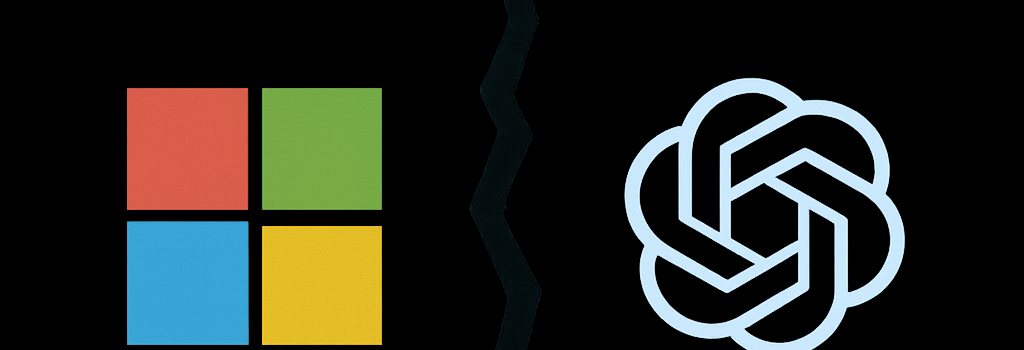AGI Definitions: Microsoft and OpenAI’s Growing Divide

Updated Sep 15, 2025
When is an AI system intelligent enough to earn the label Artificial General Intelligence (AGI)? Despite billions of dollars in research and multi-year contracts, no consensus exists—and that ambiguity is now at the heart of a bitter dispute between Microsoft and OpenAI.
The $100 Billion Profit Benchmark—and Why It’s Flawed
According to a report in The Wall Street Journal, Microsoft and OpenAI embedded a clause in their 2023 partnership agreement stating that once OpenAI’s systems generate $100 billion in net profits, OpenAI may curtail Microsoft’s future access to next-generation models. This profit-based definition reduces AGI to an economic milestone:
- Pros: Easy to measure on financial statements.
- Cons: Says nothing about reasoning, understanding, or autonomy.
By equating cognitive capacity with revenue, the companies conflate financial success with true generalization—the very attribute AGI is meant to capture.
Why AGI Remains a Moving Target
Since Mark Gubrud coined “AGI” in 1997 and Shane Legg and Ben Goertzel popularized it in 2002, the term has splintered into multiple, often conflicting definitions:
- Human-parity: Perform every task a human can (e.g., surgery, theorem proving).
- Economic value: Outperform humans in the most profitable work.
- Benchmarked tasks: Score above a threshold on specialized tests like ARC-AGI or MATH.
- Compute-driven: Cross a compute frontier (e.g., 1024 FLOPs in training).
Ask 100 experts, and you’ll get at least 100 different definitions, as Google DeepMind highlighted in their July 2024 framework paper. They proposed five levels—emerging, competent, expert, virtuoso, and superhuman—but even those tiers remain subject to interpretation.
Key Technical Challenges: Scaling, Adaptation, and Continual Learning
Most current large language models (LLMs) such as GPT-4o and Google PaLM 2 are trained on ~1023 FLOPs of compute and billions of parameters, yet they still struggle with:
- Continual Learning: Avoiding catastrophic forgetting when fine-tuned on new data streams.
- Context Length: Maintaining coherent reasoning over >32 K tokens.
- Robustness: Withstanding adversarial prompts and out-of-distribution inputs.
- Multi-modal Fusion: Seamlessly integrating vision, language, audio, and even code.
OpenAI researchers report that even GPT-4o’s 1.8 trillion tokens of multimodal training can’t yet match expert human performance in dynamic environments—evidence that compute alone won’t close the gap to AGI.
New Section: Hardware and Infrastructure Bottlenecks
AGI-scale training demands specialized hardware. Leading data centers deploy NVIDIA Blackwell GPUs with 2,048 tensor cores and 80 GB HBM3E memory, delivering up to 5 exaflops for AI workloads. Yet:
- Power Draw: 6 MW per pod translates to 20 USD/hour in electricity costs.
- Interconnect Latency: NVLink speeds of 900 GB/s create bottlenecks across 512-GPU clusters.
- Cooling Requirements: Advanced liquid-immersion systems push up infrastructure CAPEX by >30%.
Without breakthroughs in photonic interconnects or next-generation AI ASICs, the compute wall looms large.
New Section: Regulatory and Ethical Landscape
Meanwhile, policymakers struggle to keep pace. The EU’s AI Act proposes risk-based classifications but remains vague about AGI. In the US, the White House’s Executive Order on the Safe, Secure, and Trustworthy Development of Artificial Intelligence mandates impact assessments for “extremely capable” systems—yet stops short of defining AGI. Experts warn:
“Regulating AGI without a clear technical definition is like legislating gravity without Newton’s laws,” – Dr. Joanna Bryson, AI ethics researcher.
Industry self-regulation has likewise faltered. Anthropic’s Dario Amodei advocates for capability red-teaming, but without shared benchmarks, even red teams can’t agree on what “dangerous” looks like.
New Section: AGI Safety and Alignment Considerations
Beyond semantics lies a more urgent question: How do we align superhuman AI objectives with human values? Efforts include:
- Reinforcement Learning from Human Feedback (RLHF): Used by OpenAI and Anthropic to calibrate reward models.
- Constitutional AI: A technique proposed by Anthropic that embeds high-level principles (e.g., “do no harm”) into model training.
- Formal Verification: Applying theorem provers to ensure policy networks obey safety constraints.
Yet even with 99.9% compliance in simulated environments, real-world deployment surfaces unexpected failures—underscoring the fragility of current alignment methods.
Contract Law Meets Philosophy
The core dispute between Microsoft CEO Satya Nadella and OpenAI CEO Sam Altman boils down to a philosophical deadlock turned legal:
- Microsoft’s view: AGI is an economic abstraction, measured by profit.
- OpenAI’s view: AGI is a technical milestone—when models exhibit broadly human-level cognition.
Nadella has publicly derided profit thresholds as “nonsensical benchmark hacking,” while Altman insists they understand “how to build AGI as traditionally understood.” The standoff jeopardizes up to $13 billion in committed capital and could reshape future licensing terms for cloud resources on Azure.
Expert Prognosis: Timelines and Skepticism
A March 2025 AAAI survey found 76% of AI researchers doubt that scaling current architectures alone will yield AGI. However, the rapid leap from GPT-3 to GPT-4 in under two years revealed that experts often underestimate emergent capabilities. Recent timeline estimates range from 2040 to 2060 for superhuman AI, but as computing costs fall along predictable scaling laws, these projections remain volatile.
Why Clear Definitions Matter
Without a shared, empirically grounded definition of AGI, we risk:
- Misallocating research funding toward hype-driven milestones.
- Crafting regulation that lags behind genuine risks.
- Enforcing contracts on ill-defined terms, inviting litigation.
Moving forward, many experts propose abandoning the AGI monolith in favor of capability-based evaluations:
- Autonomous task acquisition.
- Multi-step reasoning across modalities.
- Robustness to adversarial and novel inputs.
Such a multidimensional spectrum avoids a single binary threshold and aligns better with both scientific rigor and policy needs.
Conclusion: Charting a Pragmatic Path Forward
As Microsoft and OpenAI grapple over semantics, the broader AI community must coalesce around specific, testable capabilities. Whether we ever settle on “AGI” as a brand name or retire the term altogether, our focus should be on measurable progress—be it in continual learning, safety alignment, or real-world robustness. Only then can industry, academia, and government coordinate effectively to harness AI’s promise while mitigating its perils.